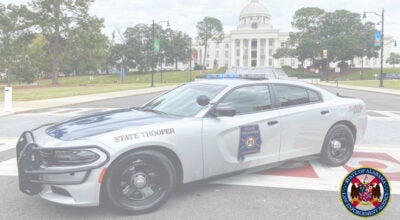Alabama drivers buck trends
Published 12:44 am Tuesday, September 10, 2013
Judging from the line of people waiting inside and out, the Andalusia driver’s license office is validation that Alabama is debunking the national trend of drivers putting fewer miles on their cars.
“I can’t tell you how excited I am,” said Christian McCuhin of Opp who was in town Monday with friend Brandon Givens so that the two could get their driving permits. “It makes me feel so good about myself. I don’t have a car yet, but I’m hopeful.”

Christian McCuhin and Brandon Givens of Opp wait outside the Andalusia driver’s license office Monday before taking their learner’s permit tests.
While most teens are happy to get behind the wheel, a study released last week by the United States Public Interest Research Group shows the number of miles driven annually per person dropped by more than 10 percent in 18 states from 2005 to 2011; however, Alabama saw a 3 percent increase.
The group’s study, titled “Moving Off the Road,” found an overall 8 percent drop in the mileage the average American drove during that period. Alabama was just one of four states — along with Louisiana, Nevada and North Dakota — that bucked the trend with an increase in mileage.
“If you go back more years and cast a wider net, you see Nevada and Louisiana had years prior to 2005 with higher percentages,” said Phineas Baxandall, the study’s author. “So really, it’s just Alabama and North Dakota who are driving more.”
The study does not explain why Alabama has seen an increase in driving, but Examiner Helen Knoebel in Andalusia has an explanation.
“It’s because there’s a lack of public transportation,” Knoebel said. “People retire here, and have to drive wherever they go. Parents shuffling kids back and forth with school and sports. Things like that keep people on the road.”
While Baxandall said he hopes his study will encourage lawmakers to back away from increasing road projects and look toward funding alternative forms of transportation, Plunk said he doesn’t see that happening anytime soon in Alabama.
“They’re doing just the opposite,” Plunk said about state lawmakers. “In fact, fuel and gas tax in this state specifically cannot go to fund public transportation.”
But even if drastic changes to policy took place overnight, Plunk said, a lot of drivers still wouldn’t change their behaviors.
“If gas prices doubled tomorrow, a lot of us wouldn’t have the option to use public transportation,” Plunk said. “We couldn’t get on the bus, or ride your bike, or even carpool.”
Baxandall said the study looked at numbers before the recession and after the start of the economic recovery to prove that the decrease in numbers wasn’t solely based on the economy.



